Positioning
Saturday, May 11
We got confirmation from "Team Denver" that they had successfully arrived the night before, picked up their rental vehicle, and were now undertaking the 8-hour journey west to the Escalante area (also see the excellent view they got of that amazing May 10 aurora). We ourselves were able to have a more relaxed morning, stopping at a local breakfast place and heading out of Salt Lake City a bit later on. The plan was for everyone to meet in the town of Escalante no later than 3pm. That was important, for we had a long shuttle operation to complete in order to properly position the vehicles in support of our long river descent (It was specifically stressed that under no circumstances were any Costco stopovers to occur that might delay arrival).

courtesy GHatko
There was a suprising amount of fresh white snow in the mountains surrounding Salt Lake City. A fairly major spring storm must have recently passed through the area, for it was clear that the snow depth at altitude was quite substantial. It made for incredibly beautiful scenery - an urban cityscape, well into springtime, with towering snow-capped mountains rising so closely by.
The drive south from Salt Lake City was - as are almost all drives in the intermountain west - grand and beautiful. We gradually transitioned from the more standard mountainous north of Utah to the Colorado Plateau Color Country in the south. By the time we reached the area around Capitol Reef National Park, we were fully in the realm of red Wingate cliffs and rounded Navajo domes. Familiar country to most of us after all our years of visiting.

courtesy JInnes

courtesy JInnes
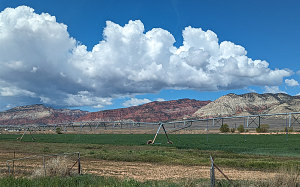
courtesy JInnes
Mountain Views from the city
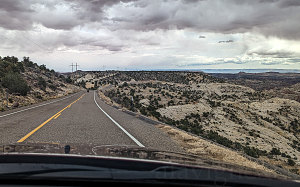
courtesy JInnes
Being slightly ahead of schedule, we could afford to make the occasional stop. As we drove along highway 12, we stopped at the point where a bridge crosses over the Escalante River. Given that we'd been endlessly checking snowpack and water flow levels for months now, it was a bit exciting to actually get a first-hand look at the river.
Now, the highway 12 crossing of the Escalante is quite a bit further upstream from where we were intending to put in, and with that in mind, we peered over the bridge railing. A small, fairly clear-watered flow bubbled peacefully southward. It didn't look that encouraging, really. Even in the deepest part of the channel it wasn't clear that a loaded packraft would freely flow. Would there be enough flow downriver at our put-in point? We'd just have to wait and see.
Taking stock at the crossing
We arrived in Escalante shortly before 2pm. Team Denver was still about half an hour out, so we decided to tick off an item on our to-do list: filling all of our water containers at the Escalante Interagency Visitor Center. There's a public-use drinking water pump outside, and at the same time Gino wanted to do an in-person registration of our goup.
We filled up every container we had as Gino went inside to talk with a ranger, returning a short while later to recount how the ranger had raised his eyebrows and started peppering Gino with all sort of questions about our itinerary, our skill level, and our experience. We were given a caution about the level of water and given some admonishments about the challenge of paddling all the way down from Fence Canyon to Hole-in-the-rock [we need an intro to the basic plan somewhere up above]. Gino kept a neutral face and kept his story consistent and positive, citing my many trips to the area and dropping our
full 2019 Death Hollow descent as a final proof of competence. That seemed to mollify the ranger but I could tell that a bit of doubt had crept into Gino's mind. Were we in fact biting off too much to chew, especially given the large size of our group?
Interagency Visitor Center
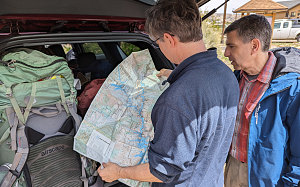
courtesy JInnes
Team Denver (the Hatkos, Chris Waddington and Brian) rolled into Escalante at about 2:30pm. We met up at the lovable little
Nemo's burger restaurant, aiming to grab what amounted to an early dinner. We had a very tight timeline to get everything in place before the day got too late.
As I've already discussed, our rafting journey down the Escalante would be starting at the point where Fence Canyon reaches the river, then following it all the way down to where it empties into Lake Powell, then across Lake Powell to a take out point at Hole-in-the-Rock. That meant we needed vehicles at closest trailheads to those two entry and exit points. For Fence Canyon, that meant the Egypt trailhead, located at the end of the Egypt side-road, not all that far from town. For Hole-in-the-Rock, that meant travelling down the full one hundred kilometre length of the road, with the condition of the road becoming rougher and rougher as one went. I had never been down to the very end of the Hole-in-the-Rock road, so I didn't really know how slow or difficult that final section would be. We estimated (hopefully conservatively) that a shuttle operation to bring everyone to the Egypt trailhead and shuttle two out of three vehicles down to Hole-in-the-Rock would take a total of six hours. And it was now nearly 3pm. Time to finish eating and get cracking.

courtesy JInnes
Coming together at Nemo's
I (and we) have been down Hole-in-the-Rock road many times. Many, many times. It is essentially the adventurer's backcountry highway to the lower Escalante region. The majority of backpacking or canyoneering routes in the area start from some point along this road or one of its side-roads.
Now, to call it a 'highway' means I need to describe it a bit more: it is not like a regular highway. It is not paved (although it seems to now be pseudo-sealed for a few miles at the start), and becomes gradually but relentlessly narrower and rougher as one descends southward, towards the general area of the confluence of the Escalante and Colorado rivers. Although it follows a generally straight course south, parallelling the straight cliffs of Fiftymile mountain on the west and the Escalante River on the east, it gets to be quite winding in its southern reaches, worming its way down to and out of every little gulch and gully eroded out of the sloping benchlands. And supposedly, according to the official documentation, it gets very rough and 4x4-ish towards the end.
Ye olde Hole-in-the-Rock Road
Now fully in convoy, we headed east out of town and soon turned right onto Hole-in-the-Rock road. After roughly 17 miles of driving, we turned left onto the side road leading to the Egypt trailhead. The side road was relatively wide and smooth at first, but as we advanced towards its end it became narrower, rougher, and more uneven. It was no problem for our SUV vehicles, provided we slowed to the appropriate speed over the various obstacles.
We arrived at the Egypt Trailhead shortly before 5pm. There were quite a few vehicles at this trailhead, as it is the starting point for any number of backpacking and canyoneering trips in the vicinity. Camping at large is allowed here, so we found spaces for our tents and mostly emptied the rental vehicles, leaving only some water and any items absolutely not needed for our rafting adventure.
It was now time to shuttle two of the three vehicles to the far end of Hole-in-the-Rock road. Based on a worst-case travel time, including negotiating any obstacles, we predicted that we'd be back at our Egypt trailhead camp between 10 and 11pm. That is one heck of a long shuttle, I know - so there was no time to waste. Chris Hatko, Gino and I departed, each of us driving one of the rental vehicles.
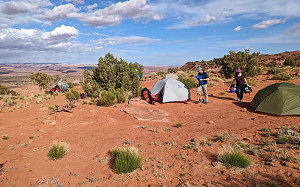
courtesy JInnes

courtesy JInnes
You'll find a collection of relaxed and fun pictures here of the six non-shuttlers chiling out at the Egypt campsite, where drinking, chatting, and shaving appeared to be the activities of choice. Meanwhile, Gino, Hatko and I did our best, stirring up big clouds of dust on our quest to make good time down Hole-in-the-Rock road.
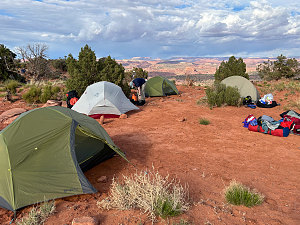
courtesy SWard
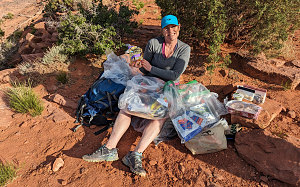
courtesy JInnes
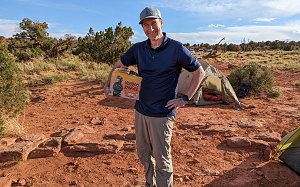
courtesy JInnes
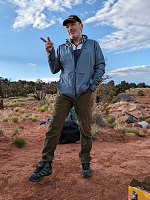
courtesy JInnes
I had never before driven beyond the turnoff to the Willow Gulch Trailhead, at mile marker 41-ish. From here, another 18 or so miles of (for me) unexplored road remained. Given the dire warnings given in print, online, and at the Ranger station, I was a bit anxious about passability, but I also knew from experience that such descriptions are often deliberately conservative. Weather and surface conditions were very good at the moment, and in all likelihood we'd be fine. Still, it was one of the trip's unknowns that I was happy to soon have resolved, one way or another.
Fortunately, Hole-in-the-Rock road mostly continued without much change (in difficulty) for some distance after the Willow Gulch turnoff: narrow-ish, rather winding, snaking into and out of gulches, and with a much coarser gravel surface than in its northern sections; but it so far wasn't any worse than the side road to the Egypt trailhead, so... so far, so good.
At the 51 ish mile mark down Hole in the Rock Road, things got distinctly rougher. The road would sometimes now cross bare slickrock, often with little shelves or drops or protrusions. Nothing that a regular higher-clearance SUV with all-wheel-drive couldn't manage, although slowly and with care in choosing the path of least resistance. Very shortly after this we came to a small cluster of cars parked along a wider area of slickrock along the road. This was the trailhead for Davis Gulch and Reflection Canyon. Was the cluster of vehicles here either because these were popular trailheads or because the road ahead was much less passible? We'd soon find out.

The hardest ledge
Very shortly after the Davis Gulch trailhead area, we came to a more significant road obstacle - a distinct down-step off the edge of a large slab of slickrock. This one was big enough that I felt it needed some scouting, so we stopped and hopped out of the cars. Other drivers had placed some small boulders in the crook of the step to make crude ramps, and after surveying the shelf from all angles, we decided that we could use these makeshift ramps and successfully navigate down and over the shelf. A bit of spotting and a slow crawl and all of our vehicles made it past this point. But... would there be anything worse than this? Anything much beyond this sort of thing may well mean the end of the journey southward for the less-capable of our SUVs.

Beautiful Slickrock, Beautiful Light
Fortunately, beyond "the shelf" obstacle, the road was again fairly easy to navigate, although I was primed and ready for something even harder to surmount. The road climbed a few really cool bits of steep bare slickrock that felt a bit airy but posed no problems with respect to clearance or grip. Minutes after that, we noticed a notch in the cliffs ahead and surmised that the notch must be the fabled Hole-in-the-Rock itself. It was quite a distinctive thing. But, and more importantly... we had made it to the end of Hole-in-the-rock road! It had been mildly challenging, sure, but once again, the warnings about the road were more severe than reality (of course, in adverse weather things would be very different). Gino and Hatko had found the drive down to be actually fun and engaging.
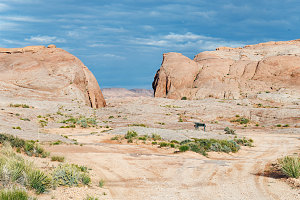
The mythical Hole-in-the-Rock
A small loop and a few parking spaces marked the very end of Hole-in-the-Rock Road. There were absolutely no other vehicles here and the spot felt quite remote - both for the lack of other humans and for the arduous drive that we had had to make to get here.
The plan was to leave two of our rental vehicles here at the Hole-in-the-Rock trailhead. They'd be able to accept all nine of us and our gear upon our [hopeful] exit out of Hole-in-the-Rock in six or seven days time.
Before heading back to the Egypt Trailhead, we felt we should have a slightly closer look at Hole-in-the-Rock itself. The descriptions of it varied - an old Mormon wagon road, a steep scramble, a short hike down to Lake Powell. Fortunately, it is only a few tens of feet from the end of the road, and so it was easy to check it out.
Gino, Hatko and I walked over to the beginning of the cut of the notch. Hm... it was narrower than I had expected. The floor of the notch dropped out of our sightline fairly quickly, signalling that it was fairly steep. Geez...the Mormons ran wagons through here!?
A beautiful slice of the deep blue of Lake Powell was visible fairly far below, along with some pretty desert landscape on the far side of the Lake. Really hard to tell what sort of climb out that was going to be, really. The distance didn't appear too far, and on paper it is a less-than-one-kilometre hike. Ah, well...another unknown, I guess, one that we'd only be able to resolve at the far end of our trip. No point thinking about it now.

courtesy GBrancatelli
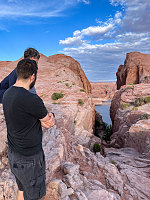
courtesy GBrancatelli
The Actual Hole-in-the-Rock
We didn't dally too long at Hole-in-the-Rock. Although we had made pretty good time getting here (roughly in two hours, where we had budgeted closer to three), it was still clear that we were going to arrive back at the Egypt Trailhead after sunset, and at the very least, we wanted to be back on the easier, less-rough stretch of Hole-in-the-Rock road before it got dark.
The drive back went pretty uneventfully. The "obstacle" (the short shelf) had to be tackled in the uphill direction on the way back, but again, a careful arrangement of stones and a bit of outside-the-car spotting, and we crawled up it without touching anything to the ground but rubber.
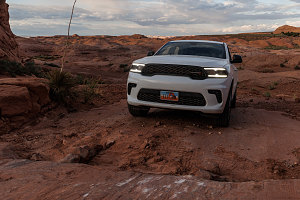
Returning to Egypt
The sun sank below the Aquarius plateau and dusk gradually crept over the landscape as we cruised back northward on Hole-in-the-Rock road. Our headlights started to become necessary as we turned back onto the Egypt side road, and by the time we slowly bumped and jostled into the Egypt trailhead parking lot, there was only a line of twilight on the western horizon. The six camp loungers were not to be seen, but they heard us arrive, and called out from the tents in surprise. They had only settled into their tents for the night just ten minutes prior to our arrival, and had not expected us for another hour or two. Indeed, we had made quite good time - not much over four hours of total driving time over nearly 100 miles (160km) of rough backcountry road driving.
Back well before 10pm was a nice finish to the day. It meant that all of us would be getting a decent night's sleep, in preparation for the big day tomorrow - the hike down to the Escalante and the first experience with our rafts on the river! Would it be an easy descent? would we be overburdened? And more importantly, would there be enough water to float our packrafts?
Interactive trackmap with photo points - The Shuttle Operation - click map to view
Vehicle Shuttle Operation - Drive Data
Start Time:
5:02p.m.
End Time:
9:23p.m.
Duration:
4h21m
Distance:
158.66 km
(98.59 mi)
Average Speed:
36.5 km/hr
(22.7 mph)
Start Elevation:
5618ft
(1712m)
*
Max Elevation:
5688ft
(1734m)
*
Min Elevation:
4145ft
(1263m)
*
End Elevation:
5580ft
(1701m)
*
* : +/- 75 feet
Total Elevation Gain:
5317ft
(1621m)
*
Total Elevation Loss:
5358ft
(1633m)
*
* : +/- 75 feet
Elevation Graph